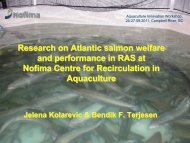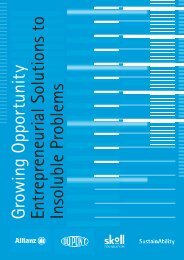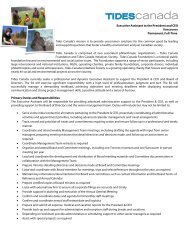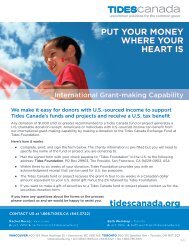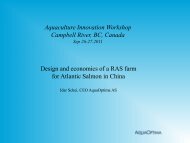The Social Purpose Capital Marketplace - Tides Canada Foundation
The Social Purpose Capital Marketplace - Tides Canada Foundation
The Social Purpose Capital Marketplace - Tides Canada Foundation
Create successful ePaper yourself
Turn your PDF publications into a flip-book with our unique Google optimized e-Paper software.
and co-operative development and environmental regeneration and conservation. In contrast to the Canadian CI<br />
sector, the US has witnessed an explosion of community investing over the past decade, testament to the impact<br />
focused efforts to scale the social finance sector can have. <strong>The</strong> recent 10 year review of community investing trends<br />
in the US, compiled by the US <strong>Social</strong> Investment Forum 10 , revealed that since 1995 community investment has<br />
grown from $4 billion USD in assets to $19.6 billion USD in 2005, a growth of 388%. This phenomenal growth<br />
is attributable to the increased number and capacity of community finance intermediaries, improved information<br />
architecture, government tax incentives, and public education and awareness of the community investment<br />
opportunities, all of which are on the radar of social finance professionals in <strong>Canada</strong>.<br />
Additionally, the US Community Reinvestment Act, which compels American financial institutions to contribute<br />
to community development finance, has played a big part in the ongoing growth of the American community<br />
investment sector.<br />
It is anticipated that these community investment trends will manifest among mission-based organizations and asset<br />
managers such as foundations, churches and asset-rich non-profits such as hospitals, educational institutions and<br />
others. While the Canadian CI markets have been slow to evolve in this space, developments south of the border<br />
are promising.<br />
• Mission-Based Investing<br />
Mission-based investing is the incorporation of an institution’s mission into its investment decision-making process,<br />
where the organization’s mission statement serves as a guide in determining what, if any, non-financial objectives it<br />
may set for its portfolio. Mission-based organizations that seek to improve societal or environmental conditions are<br />
waking up to the opportunity of using their assets in a more engaged way, an approach referred to as total capital<br />
asset management 11 .<br />
<strong>Foundation</strong>s, particularly, can benefit from this perspective. Canadian foundations allocate a minimum of 3.5%<br />
of their capital in pursuit of their entire social mission through grants, while 96.5% of capital assets are managed<br />
in pursuit of financial value, with typically 0% consideration of social mission. This bifurcation of goals can be<br />
addressed by a “unified investment strategy” (UIS) 12 , defined as an investment strategy that makes use of both<br />
philanthropic and core asset investments to maximize the blended value of those investments. A UIS views grants,<br />
below market-rate loans and market-rate investing as various tools to be used in the pursuit of a single value<br />
proposition – one that seeks to maximize economic, social and environmental value across all the organizational<br />
bottom lines. In this approach, investors view their overall investment portfolio as a single body of investments<br />
– not simply as financial investments on the one hand and charitable gifts on the other.<br />
In the US, a number of foundations (with a disbursement quota of 5% as compared to <strong>Canada</strong>’s 3.5%) are adopting<br />
asset allocation strategies that set targets or caps for investing their endowments in double bottom line investments,<br />
ranging from 1 – 3 % for large foundations to up to 40% of assets for smaller more entrepreneurial foundations. 13<br />
<strong>The</strong>se investments can be below market loans or loan guarantees or equity investments (e.g. stock purchases in<br />
social purpose businesses and partnership stakes in community venture capital and micro-finance funds) 14 . Called<br />
Program-Related Investing, or PRIs, this approach to investing is relatively small in the US, but growing. Research<br />
10 See: http://www.communityinvest.org/<br />
11 See: http://www.blendedvalue.org/publications/additional.html<br />
12 See Jed Emerson. “A <strong>Capital</strong> Idea” for a discussion of Unified Investment Strategy methods<br />
13 Mark Kramer and Sarah Cooch, Investing for Impact, p. 4.<br />
14 Neil Carlson, Program-Related Investing Skills and Strategies for New PRI Funders, p.2<br />
8





